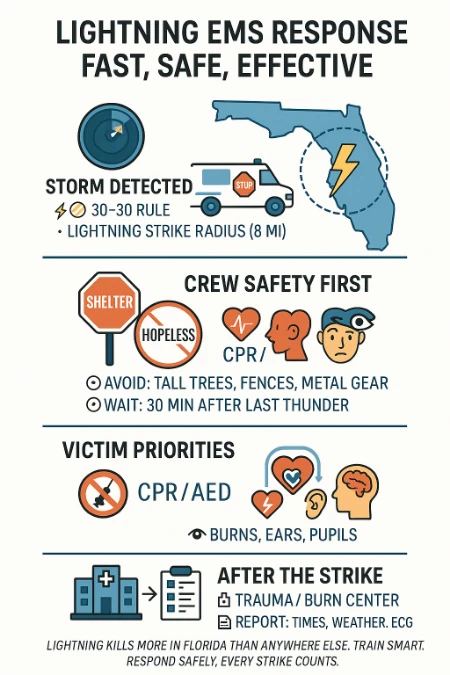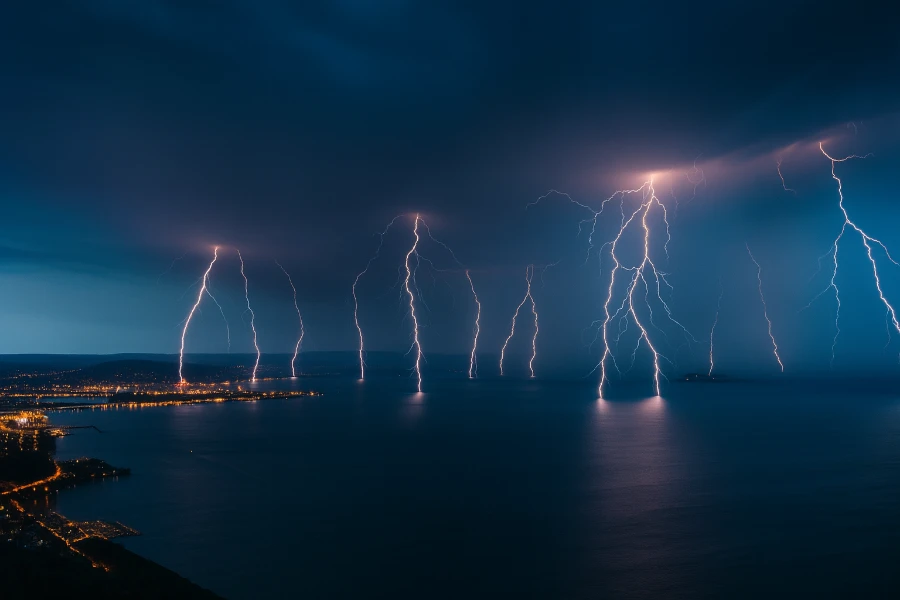Key Takeaways
- Florida’s unique lightning climate requires EMS to use real-time alerts, the 30-30 rule, and strict cold-zone staging for safety.
- Reverse triage and immediate CPR/AED intervention give lightning strike victims a high chance of recovery when executed quickly.
- Ongoing storm-specific training, upgraded PPE, equipment checks, and mental-health support keep EMS crews resilient across seasons.

Understanding the Florida Lightning Threat
Why Florida Leads the Nation in Lightning Activity
Summer heat, Atlantic moisture, and sea-breeze collisions generate towering cumulonimbus clouds over Florida each afternoon. These clouds form vertical charge layers that discharge millions of strikes yearly statewide, yielding the nation’s highest lightning fatality counts. Lake-to-Ocean temperature contrasts accelerate convection, so inland counties record the highest flash densities. Coastal breezes then push storms east or west, surprising beachgoers who assume clear skies guarantee safety. Crews who study these micro-climates schedule training and shift coverage around the peak late-day danger window. Responders who understand regional patterns position units near shelters before thunder rolls.
Common Misconceptions That Risk Crew Safety
Many Floridians still believe rubber tires insulate vehicle occupants from lightning rather than the surrounding metal cage. Some responders also think lightning never strikes the same place twice, so they linger after a visible hit. Field reports reveal repeated strikes often occur on boats, antenna masts, and metal bleachers within minutes. Another myth claims victims carry residual electricity that shocks rescuers; in reality, their bodies release energy instantly. Crews who debunk these myths during briefings strengthen on-scene decision quality and morale. Clear explanations reduce hesitation that costs precious seconds during cardiac arrest scenarios.
EMS Risk Assessment Before and During Summer Storms
Monitoring Tools and Weather Triggers for Pre-Deployment
Dispatch centers stream National Weather Service polygon alerts directly to mobile tablets, which display real-time strike density layers. Supervisors track Storm Prediction Center mesoscale discussions that highlight rapidly rising cloud-top temperatures indicating intensifying updrafts. When lightning flashes within eight miles, units implement shelter-in-vehicle protocols until the threat radius recedes. Crews also run local radar loops every fifteen minutes to anticipate gust fronts that spawn new cells. By integrating NOAA lightning mapper data, officers issue staged warnings rather than last-second evacuations. Consistent technology checks yield safer response patterns without sacrificing patient access times.
On-Scene Decision Making During Lightning-Active Conditions
Incident commanders establish a cold zone thirty meters beyond the last strike footprint, following recent research, before allowing entry. Runners relay patient status updates from that perimeter to minimize personnel exposure. Teams avoid communication towers, fences, and tied-down helicopters that channel ground currents. Responders reposition apparatus beneath overpasses only after verifying the structure’s reinforced concrete construction. Scene leaders balance urgency with electrical risk, always favoring delayed approach over a secondary casualty. Throughout operations, spotters scan cloud bases for new downdrafts that signal another strike cycle.
Safe Shelter and Equipment Protocols for EMS Teams
Hard-topped ambulances with closed doors and windows offer the quickest lightning refuge when buildings sit distant. Crews disconnect external IV pumps, oxygen tanks, and wired monitors to eliminate conduction pathways. Metal cot frames rest on non-conductive mats inside treatment bays, reducing potential side flashes. Radios switch to hands-free speaker mode, so medics avoid shoulder-mic contact during active bursts. Meanwhile, supervisors log shelter entry and exit times to enforce the 30-minute post-thunder rule. This documentation also aids quality-improvement audits after storm season ends.
Medical Response Protocols for Lightning Strike Victims
Establishing Scene Safety Before Medical Contact
Responders first verify a five-second gap exists between thunder and visible flash near the patient. Spotters then guide medics along the shortest, driest path while carrying insulated backboards. Units park downhill from tall trees to limit step voltage exposure during loading. The safety officer records continuing thunder intervals and halts care if proximity tightens. Although minutes matter, nobody compromises crew survival for premature access.
Field Assessment: Identifying Lightning-Specific Trauma
Medics scan for Lichtenberg figures—fern-like skin patterns that fade within hours yet confirm direct strikes. Tympanic membrane ruptures, unequal pupils, and consciousness changes indicate pressure-wave injuries requiring rapid transport. Cardiac rhythm interpretation often reveals asystole initially, but prompt CPR, as confirmed by a peer-reviewed study, frequently restores sinus rhythm. Sweep for secondary blunt trauma from explosive muscle contractions that throw victims several meters. Finally, monitor blood glucose; catecholamine surges sometimes precipitate stress-related hyperglycemia complicating resuscitation.
Initiating Life-Saving Measures in the Field
Rescuers deploy portable AEDs and start high-quality compressions, delivering the first shock within two minutes. Simultaneous airway management uses video laryngoscopy to offset poor visibility during heavy rain. Intravenous access proceeds on the antecubital vein opposite visible burns to avoid tissue infiltration. Heated blankets prevent rain-induced hypothermia, which worsens coagulopathy and arrhythmia risk. Clear voice commands maintain teamwork over roaring wind, ensuring synchronized ventilation and medication delivery. Crews who maintain active ACLS certification deliver evidence-based cardiovascular care during every lightning arrest.
Transport Criteria and Hospital Communication
Patients with persistent arrhythmias, deep burns, or suspected spinal fractures route directly to trauma or burn centers. Field crews transmit storm context, witnessed arrest duration, and first rhythm via encrypted radio to prepare receiving teams. En route, continuous twelve-lead monitoring detects delayed conduction blocks common after electrical injuries. Projectile debris or falls justify early CT imaging alerts for neurosurgery consults. Documenting environmental conditions aids public-health databases tracking lightning morbidity.
Psychological and Long-Term Support After Lightning Incidents
Monitoring Crew and Victim Mental Health
Survivors often describe tinnitus, memory gaps, and mood swings for weeks after discharge; clinicians schedule neuropsychology referrals early. Responders exposed to sudden booms or patient fatalities sometimes develop hyper-startle reactions during later thunderstorms. Peer support teams conduct confidential debrief sessions within 24 hours, encouraging open discussion without stigma. Supervisors provide leave flexibility for those showing stress indicators such as insomnia or irritability. Early intervention preserves workforce resilience and reduces turnover.
Debriefing and Reporting After Critical Events
Incident commanders compile strike coordinates, shelter times, and treatment intervals into standardized electronic forms. Quality committees review whether crews respected the 30-30 rule and reverse-triage principles. Findings feed protocol revisions, equipment purchases, and annual refresher curricula. Public information officers distill lessons for community outreach while safeguarding patient confidentiality. Transparent reporting fosters trust among residents who expect lightning-ready emergency services.
Public Safety Messaging and Bystander Education
Teaching the 30-30 Rule and Reverse Triage to the Public
Outreach teams visit schools and beach concessions before storm season, demonstrating smartphone alert settings and safe-shelter maps. Educators use role-play scenarios where students act as first rescuers performing hands-only CPR on manikins. Visual aids show reverse-triage priority, emphasizing that pulseless victims can still survive lightning arrest. These sessions empower witnesses to act decisively until EMS arrives. Community engagement reduces fatal pre-EMS delays each summer.
Managing Crowds and Hazard Zones in Public Spaces
Event planners embed weather liaisons who monitor lightning networks and activate mass-text evacuation plans. Security staff deploy portable speakers directing crowds toward enclosed arenas rather than open concourses. Medical tents position generators and surge protectors under steel-framed shelters grounded to code. Meanwhile, EMS staging zones relocate to parking garages, ensuring rapid egress while preserving responder safety. Coordinated drills ensure every partner knows exact movement routes weeks before hurricane season.
Crew Protection and Equipment Standards in Lightning Conditions
Personal Protective Equipment Requirements
Fire-resistant uniforms with moisture-wicking layers reduce steam burns when rain contacts hot skin. Insulated composite-toe boots lower step-voltage risk across saturated ground. Lightweight Kevlar helmets with integrated headlamps free hands for airway work during dim squalls. Non-conductive goggles shield eyes from wind-blown debris without fogging. These upgrades enhance safety without limiting dexterity or adding unnecessary weight.
Vehicle and Equipment Inspection Before and After Storm Events
Technicians test surge suppressors on cardiac monitors and ventilators each morning shift. After storms, crews inspect ambulance antenna mounts for arc marks that signal near strikes. Battery chargers receive thermographic scans identifying hidden heat damage from voltage spikes. Inventory specialists log any compromised gear, triggering immediate replacement orders. Rigorous maintenance guarantees readiness for the next inevitable thunderhead.
3 Practical Tips
- Designate a storm safety officer on every multi-unit scene; that leader tracks thunder intervals and shelter compliance.
- Assume every pulseless lightning victim can recover; high-quality CPR and rapid defibrillation often restore circulation.
- Wait thirty minutes after the final thunderclap before resuming outdoor operations, ensuring unseen charge pockets dissipate.
Frequently Asked Questions
What’s the safest way to approach a lightning strike victim in an open field?
Walk at a right angle to the last visible strike to avoid residual ground currents. Maintain a low profile, then move the patient to a hard-topped vehicle or building before definitive care.
How do I know if a patient was directly struck or affected indirectly?
Direct strikes usually leave Lichtenberg figures and central entry burns, while indirect injuries present with side-flash or ground-current patterns. Either scenario warrants the same rapid ABC assessment and cardiac monitoring.
Are lightning victims always unconscious or can symptoms be delayed?
Some patients regain consciousness quickly yet develop arrhythmias, memory loss, or muscle pain hours later. Continuous observation and follow-up ensure subtle complications receive timely treatment.
What gear increases the risk of being struck during a callout?
Handheld metal stretchers, elevated antenna poles, and open aluminum ladders attract step voltage. Crews should substitute non-conductive tools whenever thunder clouds loom overhead.
Reinforcing Resilience in Florida EMS Crews
Annual academy curricula now embed lightning modules featuring live radar simulations and staged reverse-triage drills. Agencies rotate seasoned mentors through rookie crews, enhancing paramedic training with storm-specific tactics and equipment hacks. Post-season reviews compare response metrics, highlighting units that maintained zero exposure injuries during peak storms. Leadership rewards proactive hazard reports, reinforcing a culture where safety improvements flow from every rank. With deliberate practice and data-driven adjustments, Florida EMS stands ready for the next crackling sky.
Critical EMS Action Checklist
| Phase | Key Action |
|---|---|
| Pre-Storm | Monitor NWS alerts, stage units near sturdy shelters, brief crews on risks. |
| Active Storm | Suspend outdoor work, seek hard-topped vehicles or buildings, track 30-30 rule. |
| Immediate Post-Strike | Conduct reverse triage, start CPR and defibrillation, secure airway. |
| Transport | Route to trauma or burn center, transmit ECG and scene data en route. |
| Aftermath | Debrief crews, inspect equipment, update protocols based on incident review. |
By combining vigilance, evidence-based medicine, and community outreach, responders transform Florida’s lightning reputation from deadly threat into a manageable challenge.

Jeromy VanderMeulen is a seasoned fire service leader with over two decades of experience in emergency response, training, and public safety management. He currently serves as Battalion Chief at the Lehigh Acres Fire Control & Rescue District and is CEO of the Ricky Rescue Training Academy, a premier provider of online and blended EMT and firefighter certification programs in Florida.
Jeromy holds multiple degrees from Edison State College and the Community College of the Air Force, and is pursuing his MBA at Barry University. He maintains top-tier certifications, including Fire Officer IV, Fire Instructor III, and Fire Inspector II, and has served as a subject matter expert for a court case. He is a member or the Florida Fire Chiefs Association.
Jeromy also contributes to state-level fire safety regulation and serves on several hiring and promotional boards.

